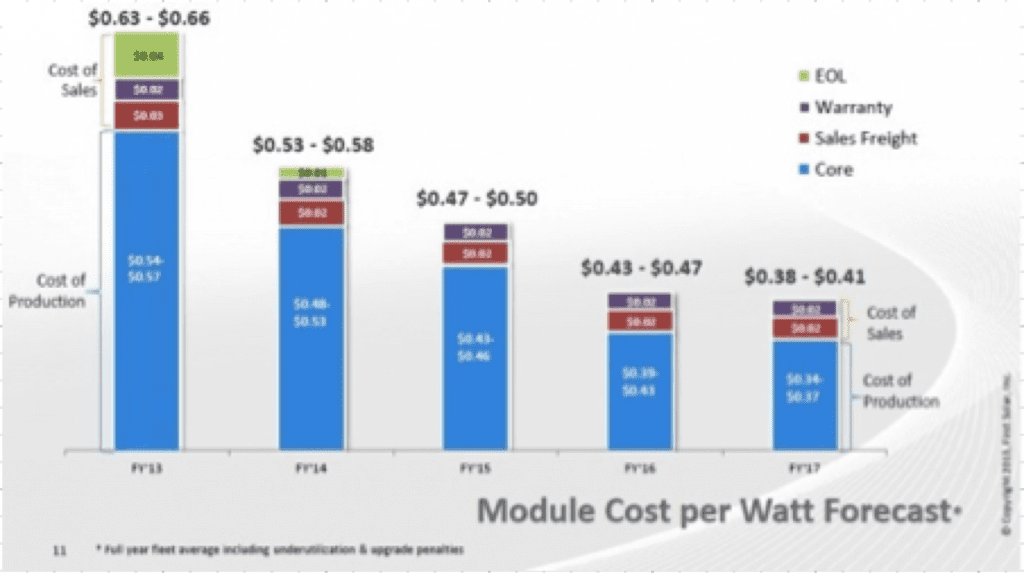First Solar announced a new world record for cadmium-telluride (CdTe) solar cell efficiency – 20.4%, a figure confirmed by the National Renewable Energy Laboratory (NREL). The new efficiency now matches the research cell efficiency record of multicrystalline silicon, a popular competitor to the CdTe thin-film technology.
The new record is the result of a joint research effort with GE Energy and incidentally, the previous record of 19.6% efficiency was achieved in 2013 by GE Global Research, which First Solar acquired in April 2013.
The announcement comes only a few months after First Solar announced the largest quarterly reduction in module fabrication costs late last year and is part of a longer-term R&D effort from First Solar to act on a bullish technology and cost roadmap it announced in collaboration with Intermolecular in 2012.
Prior to selling its CdTe R&D assets to First Solar, GE aimed to create modules with routine efficiencies of 15% and had previously mentioned the possibility of achieving over 20% efficiency. First Solar’s Chief Technology Officer, Raffi Garabedian comments, “The synergy realized in our partnership with GE also demonstrates the value of our consistent and strong investment in R&D”.
The CdTe technology championed by First Solar claims a number of technical advantages including better tolerance to high temperatures, the smallest carbon footprint, lowest water use, and fastest energy payback time compared to all other solar PV technologies. However, CdTe’s biggest advantage is cost, with manufacturing costs expected to go below USD $0.49 over the next year (see graphic below for First Solar’s cost roadmap) – making them an apples to apples comparison with multi-crystalline modules.
 Image Credit: First Solar via PV-Tech
Image Credit: First Solar via PV-Tech
Says Garabedian, “This record marks another achievement in our mission to unlock the industry-changing potential of CdTe PV…We are demonstrating improvement in CdTe PV performance at a rate that dramatically outstrips the trajectory of conventional silicon technologies, which have already plateaued near their ultimate entitlements”.
The steady increase in industrial module efficiencies reported by First Solar in recent months – the last being 13.9% at the end of 2013 – as well as the fact that the record-setting cell was constructed at First Solar’s Perrysburg-based factory/R&D centre gives hope that the new cell technology will result in more efficient commercial modules soon. Garabedian claims, “The advanced technologies and processes we developed for this record-setting cell are already being commercialized and will positively impact performance of our future production modules and power plants.”
Apart from targeting higher efficiencies and lower costs, First Solar has also been making the news in Australia for other reasons: Barely a month ago, the vertically-integrated company, which provides not only panels but also engineering and procurement services, broke ground on the 102 MW Nyngan solar farm, New South Wales’ first commercial solar farm and Australia’s largest so far.
Top Image Credit: First Solar via PV-Magazine
© 2014 Solar Choice Pty Ltd
- Future of Utilities – Part 1: The death of base-load generators - 11 September, 2014
- Sharp enters energy storage market with SmartStorage - 18 August, 2014
- Phinergy extends electric car range with metal-air battery technology - 13 August, 2014
Nitin
I have a yacht and am interested to find the highest efficiency pv cell type currently available. Cost per kw is not a concern…I intend sailing in tropical and temperate zones so insolation will vary enormously. Key issue is to maximise amp hours into my batteries per hour of variable insolation. Does anyone sell a multi- junction panel commercially today?
Anthony
Dear Anthony,
Thanks for your interest in my article and for your question!
If highest energy output per installed kW is what you’re after, you may want to consider SunPower modules. Photon International publishes an annual module test report, where they install panels of different power ratings (kW) and measure the actual energy output for 1 year (in kWh). The modules then get ranked by their yield (kWh/kW). A copy of the 2013 report (all 3 SunPower modules were unfortunately excluded in 2013 due to a testing machine malfunction) as well as the 2012 report.
The modules are laid out on an outdoor test facility in Aachen, Germany; so keep in mind that they reflect best performance for that particular climate. As far as I am aware, nobody else does such continuous and thorough testing of new modules for tropic climates; however, if you don’t expect the module to heat up significantly for a long time, Photon Intl’s results will still be very much relevant.
As far as I am aware, nobody sells multi-junction panels for standard rooftop/terrestrial applications due to cost reasons. Almost all multi-junction panels are either used in space applications or in concentrator PV applications on earth, where expensive mirrors and lenses are required to extract the high efficiencies. Note that multi-junction panels for concentrator applications are typically much smaller than standard 72-cell terrestrial panels.
Concentrators require not only lenses/mirrors but also 2D trackers to track the sun and ensure. Most multi-junction panel manufacturers such as Amonix (holds the world record for highest panel efficiency) automatically assume that you will be using their panels in concentrator applications and generally claim efficiency figures for concentrator applications (efficiency decreases with reduced concentration of light). I’ve never come across anybody using such panels for non-concentrator applications, but I suppose you could contact Amonix to see what they think about it.
I hope that helps!
Best regards,
Nitin